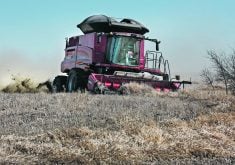MORDEN, Man. Ñ Soybeans’ ability to fix nitrogen into the soil has improved over the past 20 years in Manitoba, but growers should not rely too much on nitrogen left from that crop to support cereals or oilseeds planted the following year, says Manitoba Agriculture soil fertility specialist John Heard.
“Up until a few years ago, the soybean crop couldn’t even satisfy itself,” Heard told growers during a recent bean symposium in Morden.
That was evident in the 1980s and early 1990s when growers found themselves with low protein soybeans, the result of plants not nodulating enough to satisfy even their own nitrogen needs.
Read Also

VIDEO: Ag in Motion documentary launches second season
The second season of the the Western Producer’s documentary series about Ag in Motion launched Oct. 8.
There have been improvements since then, Heard said, and nitrogen fixation is no longer the challenge that it used to be with soybeans. The question now is whether growers should count on nitrogen left in the soil from soybeans to provide fertility for the following year’s cereal or oilseed crop.
Research in Manitoba has shown that soybeans can leave “a pretty hefty chunk” of nitrogen in the soil.
However, Heard advised sticking with a unique philosophy in Manitoba that does not grant nitrogen credits to pulse crops.
“We’ve stuck to our guns. We’ve really not changed our pulse nitrogen philosophy,” he said.
“We still say count on that yield bonus when you’re growing cereals or corn after soybeans. To collect that yield bonus, you need to fertilize with nearly the same amount of N as if you’re following cereals or flax.”














